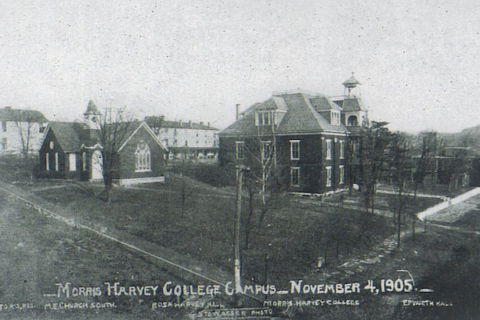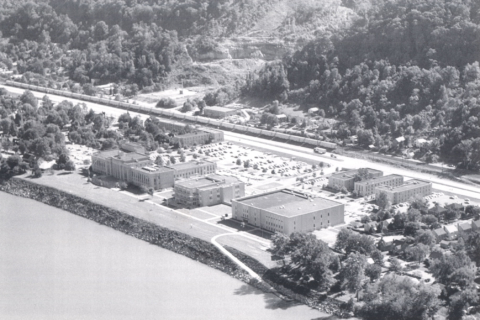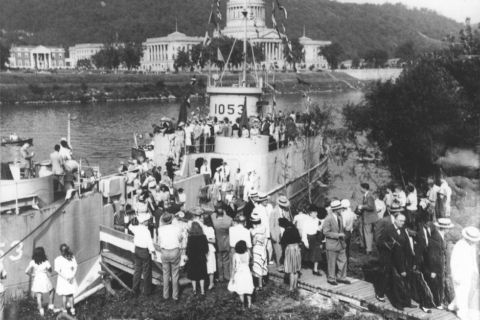History
The University of Charleston has grown from a small seminary school to a thriving, independent university.
September 12, 1888
The University of Charleston was founded in Barboursville, West Virginia, as Barboursville Seminary, affiliated with the Methodist Episcopal Church South. The first campus was located in the courthouse complex that was abandoned when Cabell County moved its seat of government to Huntington. There were 25 students enrolled.
1901
A substantial gift from a Fayetteville coal operator, Morris Harvey, helped the struggling school eliminate its substantial debt. In gratitude, the school was renamed Morris Harvey College and embarked on a building and renovation program.
1930s
Under the guidance of Leonard Riggleman, the school’s 19th president, the college went from the depths of the Depression to a fully accredited institution located on a growing campus. In a major decision that saw the board of trustees reverse itself three times within one week, the college accepted an invitation from the Charleston Education Center and opened in temporary quarters in downtown Charleston on September 11, 1935.
1940s
The next several years saw many changes. Enrollment soared, and Morris Harvey College affiliated with Kanawha Junior College and the Mason College of Fine Arts and Music. Enrollment increased to over 1,500 by 1941. World War II halted growth and the college disaffiliated from the Methodist Church, becoming an independent college in 1942.
September 8, 1947 – The University moved to the south bank of the Kanawha River, the current location, before a crowd of hundreds. Buildings were ferried across the river to the new location. The campus consisted of five government surplus buildings, three barracks-type buildings, a Quonset hut, a small frame building and a cafeteria/assembly hall.
A cinder block building was erected in 1948 as a student activities building.
1950s
The college continued to build its campus, including the completion of Riggleman Hall in 1951. That same year, the school purchased the Young-Noyes House as the home for the college president.
1960s and 70s
UC continued to grow, with the Geary Student Union, Cox Hall and Gorman Physical Education Building all being completed. John F. Kennedy addressed a full-capacity crowd in Geary Student Union in 1960 to kick off his presidential campaign in West Virginia. In 1964, the student activities building was named the Eddie King Gymnasium.
The MHC basketball team went to the Final Four and Elite Eight in back-to-back seasons, and 1971 saw the highest enrollment in the school’s history, with over 3,000 students.
On December 13, 1978, Morris Harvey College was renamed the University of Charleston.
1980s and 90s
In 1989, the University of Charleston welcomed Dr. Edwin H. Welch as its President, and a new era of growth began.
In 1991, the president’s house was listed on the National Register of Historic Places.
In 1993, a new mission statement was adopted: to educate each student for a life of productive work, enlightened living and community involvement.
On September 7, 1997, fifty years after Morris Harvey College first occupied the current location, the Clay Tower Building was dedicated. The seven-story building was called an “instant landmark” and has become a recognizable symbol for the University.
2000s
UC continued to experience growth and significant changes. In 2000, the University initiated the Independent College Enterprise which provides shared academic and administrative computing hardware to eight schools in four states. The main entrance to campus was moved to improve traffic flow. Football returned to campus in 2003, and new structures were built, including Brotherton Hall, Ratrie Hall, Middle Hall, East Apartments and the parking garage. The Riggleman Hall library was transformed into the Erma Byrd Gallery, home to the West Virginia Women Artists Collection, in 2004.
Morrison Fitness Center was completed in 2007, providing students and staff a state-of-the-art facility.
New programs were also introduced, including the school’s first doctoral program, with the opening of the School of Pharmacy in 2006. The Graduate School of Business and Leadership opened in downtown Charleston in 2008, and the Physician Assistant program welcomed its first cohort in 2013.
In 2012, UC established locations in Beckley and Martinsburg through a teach-out agreement when Mountain State University lost its accreditation and closed. This also led to the establishment of a growing online program serving students around the world.
In 2014, the Eddie King Gym – the oldest building on campus – was closed in preparation for the construction of the Martha and Russell Wehrle Innovation Center. The Center opened in 2017 and is home to an array of opportunities for students to create, build, dream and discover. The Center also houses the H. Bernard Wehrle Athletic Arena, where UC basketball and volleyball teams take the court.
In 2017, Dr. Edwin Welch announced he would graduate with the Class of 2018, and retired as President after 29 years. The University named Dr. Martin Roth as its 26th President, and President Roth took office in July 2018.






